A richly delicious vegan dish that delivers some serious flavor, Persian eggplant stew is an easy recipe to make, one that will impress your friends and family.

Moreover, this hearty stew brings some classic Middle Eastern spice that elevates it beyond your typical comforting stew to something even more special. If you know anyone who turns their nose up at vegan food, cook this for them and watch them change their mind!
Why you'll love this Persian eggplant stew recipe
- It's a great example of how vegan food can taste fantastic
- All the ingredients are fresh, giving you a light yet delicious recipe
- It's an excellent showcase for just how delicious eggplants can be
- Persian dishes combine fresh vegetables with fragrant spices to spectacular effect!
Equipment needed
There are a few essential pieces of equipment you'll need before starting this recipe:
- Large pot or Dutch oven – for me, a Dutch oven is a must in any kitchen. If you want to go for something that will go the distance and be a constant companion in your kitchen, I recommend going for a Le Creuset pot. They are pricey, yet totally worth the money. Trust me... you won't regret it!
- Baking sheet – you'll need this for roasting your eggplants

How to make Persian eggplant stew
You need eggplant, onion, chickpease, oil, tomato paste, salt, smoked paprika, ground cinnamon and black pepper for this recipe.


Cut the eggplant into chunks, season with salt and let it sit for an hour. Rinse the salt, pat dry and place in a baking sheet.
Roast until cooked. Set aside.

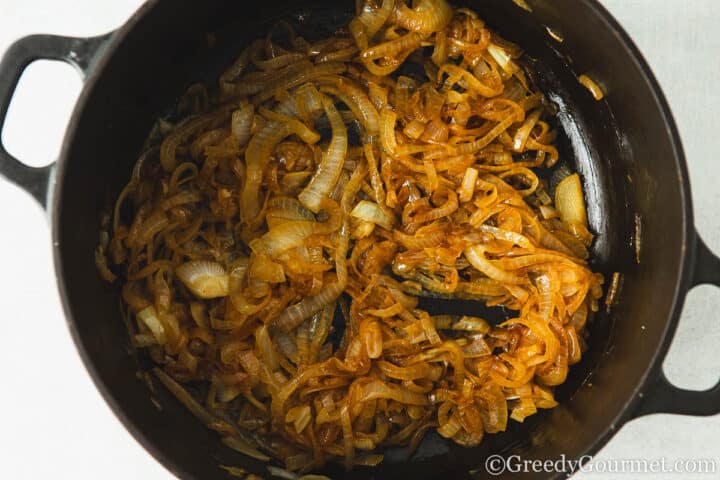
Slowly cook the onions in the oil until they're caramelized.
Add the tomato paste and the spices.
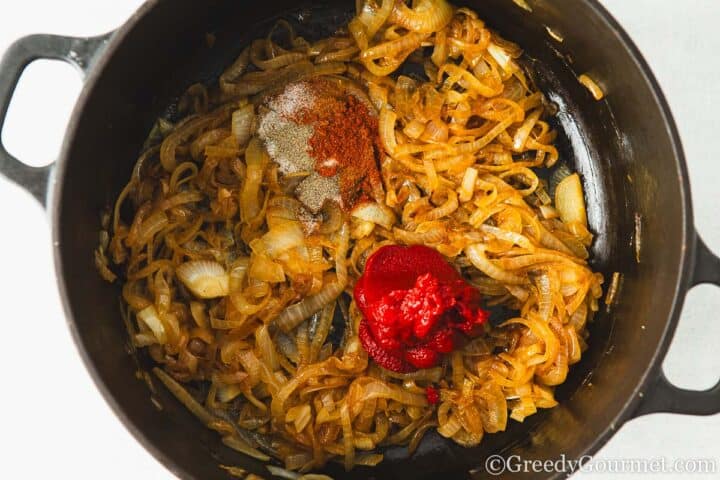

Add water until a thick sauce forms.
Tip in the cooked eggplant and chickpeas.

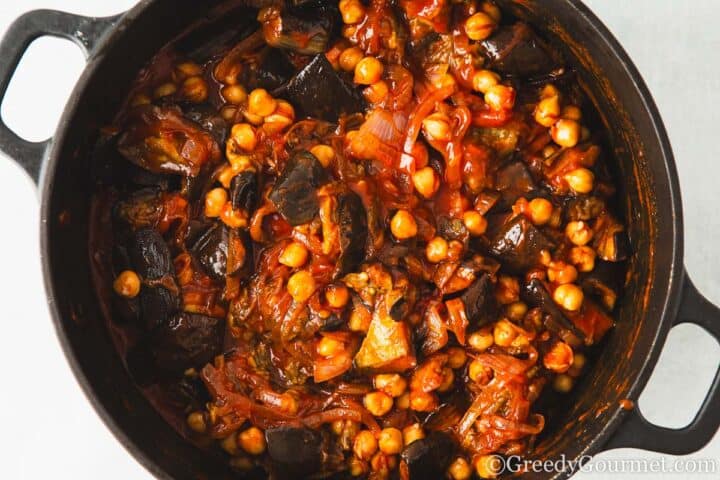
Let it simmer for 15 minutes and serve immediately on fluffy rice with cilantro. Enjoy!
Top Tip
Allow the salt to soak into the eggplant for at least an hour before rinsing and wiping dry.
How to serve Persian eggplant stew
Sides
Like many traditional Persian dishes, Persian eggplant stew is often served as a large main dish at the center of the dining table for a family-style feast.
Would you like to save this?
It's then accompanied by traditional Persian steamed rice garnished with fried tomato halves and fresh herbs.
You can also pair this dish with other types of rice. Try my sensational egg fried rice recipe, which is full of flavor. Pita bread or vegan yogurt are other great side options.
Wine pairing
The richness of this stew, the acidity of the tomato sauce, and the subtle spices make a crisp white wine ideal.
I think a Sauvignon Blanc would be a glorious pairing with this dish. Go for a Chilean variety.
Variations and substitutions
- You can replace the tomato paste with canned tomatoes. One can will do.
- Add red pepper flakes for an injection of heat to this vegetarian stew.
- Replace the water with vegetable broth for a richer stew.
- Add a squeeze of fresh lemon juice to give this stew a zesty flavor.
- You can replace chickpeas with yellow split peas or other legumes.
- Add some other fragrant spices, such as turmeric and saffron.
- You can use herbs to add flavor, such as fresh parsley and fresh cilantro.
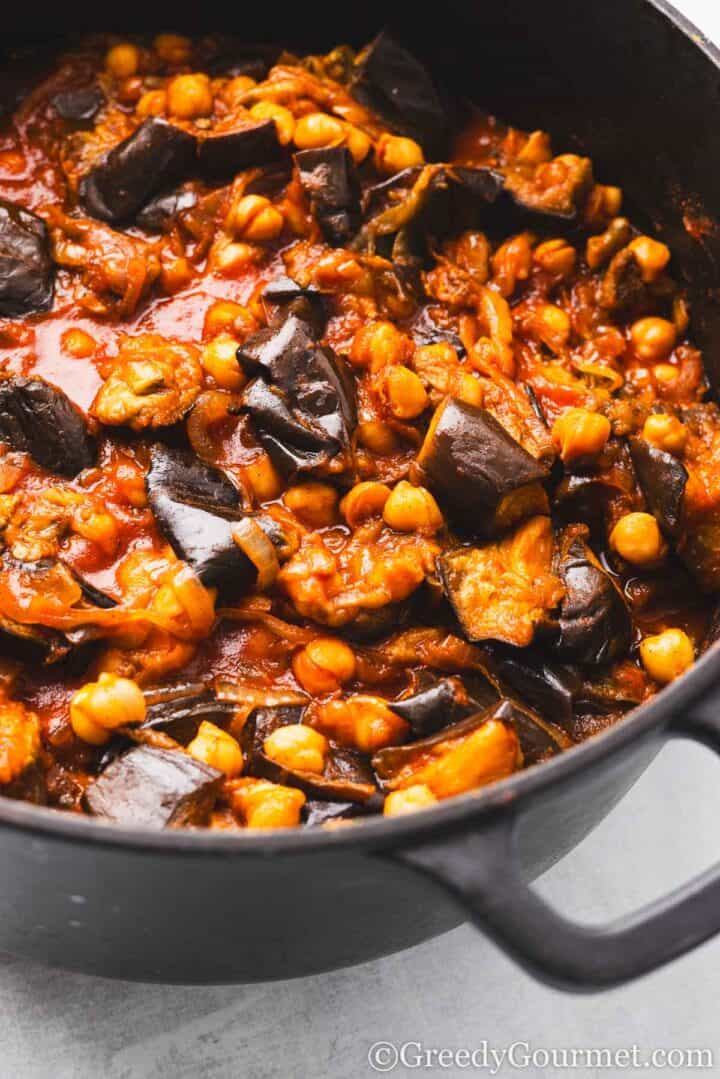
What is Persian eggplant stew?
Otherwise known as khoresh bademjan, this is a classic Persian eggplant recipe served at Iran's most traditional dinner parties.
Traditionally, this authentic, hearty dish uses Persian dried limes and pickled sour grapes, giving it a sweet and sour character. However, these ingredients are very difficult to source and aren't necessary for this recipe.
Also, this authentic Persian stew isn't always vegan. Sometimes, it's served with beef or lamb.
In Persian, the word khoresh means "stew," and the word bādemjān means "eggplant."
When was Persian eggplant stew invented?
Authentic Persian eggplant stew has a long, storied history within Persian cuisine. You'll find this recipe in one of the oldest Arabic cookbooks, documenting this authentic, hearty dish as long as 1,000 years ago.
Early recipe versions were flavored with vinegar instead of tomato, and most were served with a medley of spices, cooked eggplant, and meats such as lamb and beef.
What are the best eggplants for this dish?
What... you mean there's more than one?!
Yes, there are many different eggplants, each with a unique taste and texture profile.
Here are a few of the best types of eggplants to use when making Persian stews:
American eggplants
The standard type of eggplant, American eggplants, also known as globe eggplants, can be found in most good supermarkets or grocery stores. They are perfect for roasting or grilling and can withstand rich flavors.
Italian eggplants
Also known as rosa bianca, Italian eggplants are globe-shaped aubergines that are great when roasted. Their flesh tends to be more tender than American eggplants when cooked, although the spongy texture of the flesh is perfect for taking on the flavor of spices and sauces.
Graffiti eggplants
Known for their striking light purple coloring and white etched patterns (hence the name), graffiti eggplants have a sweeter taste and creamier texture than other eggplants once cooked.
Japanese eggplants
These thin, lilac-colored eggplants bring a sweet taste to dishes. However, they must be the right shape for stew recipes; they work better in stir-fries.
White eggplants
Although white eggplants are a little milder in flavor than American or Italian eggplants, they still work really well for roast recipes. Of course, their white skin sets them apart, adding a different dimension to your dish.
How do you stop eggplant from going soggy?
Eggplants are known to soak up liquid while cooking. This makes them great for taking on flavor but also means they can become soggy.
Cover the eggplant in salt to prevent sogginess and greasiness in eggplants, and let it sit for about an hour. This process helps to draw out the moisture.
Next, rinse the eggplants and pat them dry before cooking.
Do you keep skin on eggplant when roasting?
As the skin of eggplants is edible, there's no need to peel eggplant before cooking. If you want to peel the skin from the eggplant before roasting it, use a vegetable peeler or paring knife to remove it.
Can this recipe be made ahead of time?
This stew tastes even better the next day as the flavors meld together. You can make it in advance and store it in the refrigerator. When ready to serve, reheat gently on the stovetop.

More delicious eggplant recipes
Want to get more out of this glorious, underrated vegetable? Go beyond this eggplant and tomato stew and make some of these amazing eggplant recipes:
- Japanese miso eggplant – beautiful umami flavours that will send your taste buds into overdrive
- Melitzanosalata – a traditional Greek dip that uses charred aubergines to great effect. Like this burnt aubergine veggie chilli, you place the aubergine onto a lit ring to char completely, before whizzing it up in a food processor with garlic, oil and herbs
- Mutabal – a Middle Eastern marvel, this dip is ridiculously easy to make and tastes absolutely fantastic!
- Masala grilled aubergine – healthy, delicious and simple, this is an Indian starter you HAVE to try
- Brinjal bhaji – a delicious healthy curry, this recipe proves that aubergine can be a star ingredient
📖 Recipe
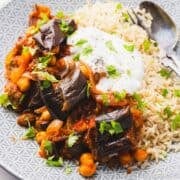
Persian Eggplant Stew Recipe
- Total Time: 2 hours 15 minutes
- Yield: 4 portions 1x
- Diet: Vegan
Description
Discover the rich flavors of Persian cuisine with our Eggplant Stew recipe, featuring tender eggplant simmered in a savory tomato-based sauce.
Ingredients
Roasted Eggplant
- 1kg eggplants (aubergines)
- 1 teaspoon salt
- 2 tablespoons vegetable oil
Eggplant, Tomato and Chickpea Stew
- 1 tablespoon olive oil
- 1 large onion, halved and thinly sliced
- 1 teaspoon salt
- 4 tablespoons tomato paste
- ½ teaspoon pimento / smoked paprika
- ½ teaspoon ground cinnamon
- ¼ teaspoon black pepper
- 1 14oz can chickpeas, rinsed and drained
To Serve
- Rice or bread
- Cilantro
- Vegan yogurt
Instructions
- Roasted Eggplant: Cut the eggplants (aubergines) in half and slice each half into 3-4 pieces. Set them on a rimmed baking sheet or large colander and sprinkle with 1 teaspoon of salt. Let them stand for 1 hour, then rinse the eggplants and pat them dry.
- Preheat your oven to 400°F/200°C/gas mark 6. Line a baking sheet with parchment paper for easy cleanup.
- Arrange the eggplant slices on the prepared baking sheet. Brush them with 2 tablespoons of vegetable oil, ensuring they are well-coated.
- Roast the eggplants in the preheated oven for about 25-30 minutes, flipping them halfway through or until they are tender and golden brown. Remove from the oven and set aside.
- Eggplant, Tomato, and Chickpea Stew: Heat 1 tablespoon of olive oil over medium heat in a large pot or Dutch oven. Add the sliced onion and 1 teaspoon of salt. Stir occasionally for 10-15 minutes or until the onions are softened and golden at the edges.
- Add 4 tablespoons of tomato paste, ½ teaspoon of pimento/smoked paprika, ½ teaspoon of ground cinnamon, and ¼ teaspoon of black pepper to the onions. Toss for another minute to let the spices bloom.
- Pour about 2 cups of water into the stew and stir well to combine. If you prefer a thicker stew, use less water. If you prefer a thinner sauce, use more.
- Gently add the roasted eggplants to the pot, being careful not to break them. If you're using chickpeas, add them now as well.
- Bring the mixture to a boil, reduce the heat to low, cover the pot, and simmer for another 10-15 minutes to allow the flavors to meld together. If you'd like a thinner consistency, add more water as needed.
- To Serve: This stew can be enjoyed warm or at room temperature, but it tends to taste even better after some time for the flavors to meld.
- Serve the Persian Eggplant Stew with rice or bread. If desired, garnish with fresh cilantro and a dollop of vegan yogurt.
Notes
- Deep Frying Option: If you prefer a slightly different texture and flavor, deep fry the eggplants instead of roasting them. To do this, follow these steps:
- Heat vegetable oil in a deep fryer or heavy Dutch oven to 350°F/180°C.
- Carefully place the eggplant pieces into the hot oil, working in batches to avoid overcrowding.
- Fry the eggplants on both sides for about 5 minutes or until golden brown.
- Drain the fried eggplants on paper towels and pat them with more paper towels to remove excess oil.
- Adjusting Consistency: You can change the thickness of the stew to your preference by adding more or less water. If you prefer it thicker, use less water; if you like it thinner, add more water during cooking.
- Make-Ahead: This stew tastes even better as the flavors meld together the next day. You can make it in advance and store it in the refrigerator. When ready to serve, reheat gently on the stovetop.
- Serving Suggestions: In addition to cilantro and vegan yogurt, you can serve this stew with a squeeze of lemon juice for a citrusy kick or a sprinkle of sumac for extra flavor.
- Accompaniments: Besides rice or bread, consider serving the stew with pickles, olives, or a simple salad to complete the meal.
- Prep Time: 15 minutes
- Cook Time: 2 hours
- Category: Dinner
- Method: Simmer
- Cuisine: Persian
Nutrition
- Serving Size:
- Calories: 268
- Sugar: 12.4 g
- Sodium: 1454.9 mg
- Fat: 12.8 g
- Saturated Fat: 6.4 g
- Trans Fat: 0 g
- Carbohydrates: 35.1 g
- Fiber: 13.4 g
- Protein: 8.5 g
- Cholesterol: 0 mg

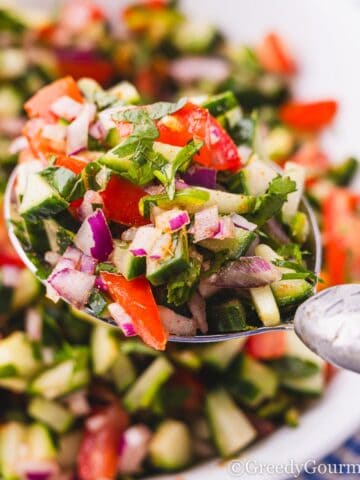



Make my day! - Share your thoughts...